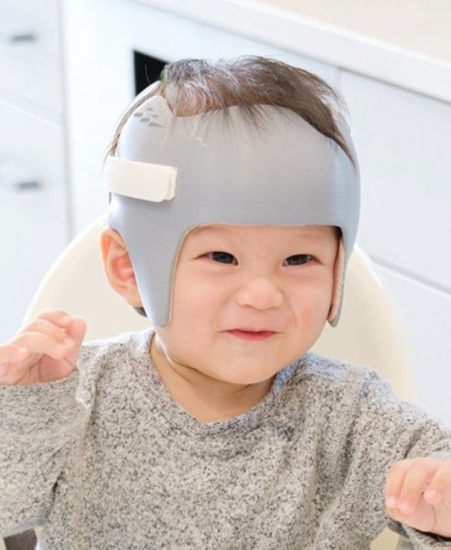| Flat Head Syndrome |
|
Flat Head Syndrome
(Deformational Plagiocephaly) Understanding, Preventing and Treating Flat Head Syndrome in Babies Andrew McPhail
CO(c)
Angela Creighton-Leroux
CPO(c), MSc
Christa Brown
CO(c), MSc
Dawn MacArthur Turner
CO(c), MSc, FCBC
Grace Chung
CO(c), MSc
Heather Mackenzie
CO(c)
Jonathan Blunt
CO(c)
Linda Lui
CO(c)
Lucy Lacoursiere
CO(c)
Shane Bates
CPO(c)
Shaughn Reilly
CO(c)
Edited by: Anne Whitney
CO(c), MSc
© 2024 Orthotics Prosthetics Canada
Background Information on Deformational Plagiocephaly In the 1990s a national campaign called “Back to Sleep” was launched with the goal of reducing the incidence of Sudden Infant Death Syndrome (SIDS). It is now known as the “Safe to Sleep” campaign and it has been successful in reducing the incidence of SIDS by 50%. The Safe to Sleep guidelines direct caregivers to place infants on their backs for sleep, which has led to an increase in the prevalence of deformational plagiocephaly (often called “flat head syndrome”). [1] The majority of human head growth occurs in the first year of life. [2] This is due to rapid brain growth that expands the bones of the infant’s skull. [3] During this period of rapid growth the skull bones are soft and moldable. Therefore, if an infant is lying on a surface for a long time, it can cause growth restriction in one area of their head and redirect it to another. [4] Most cases of flat head syndrome develop during an infant’s first three months of life, although one in five cases are present from birth. [5] If the flat spot is more noticeable on one side of the head, it is called plagiocephaly. Plagiocephaly can cause the ears and face to become uneven. If the flat spot is central on the back of the head, it is called brachycephaly. Babies with brachycephaly usually have tall, wide heads. A long and narrow head shape is called scaphocephaly.
Head shape deformities [Render]. Bates, S (2023)
This image shows plagiocephaly.
The risk factors contributing to flat head syndrome continue to be investigated. They are broken down into three categories: biological, obstetric (relating to childbirth) and infant care. Biological risk factors include male gender, lower infant activity level, and a preference to turn the head to one side. [6] One possible cause of such a preference is torticollis, which is a congenital muscular condition affecting the neck. Torticollis results in tightness in the sternocleidomastoid muscle. This causes the child to tilt their head to one side and turn to the opposite side. [7] Obstetric factors include intrauterine constraint, multiple births (i.e. twins), as well as an assisted delivery. [6] Finally, the positioning of the infant in their environment is related to the development of flat head syndrome. [6] Caregivers can reduce this risk by repositioning their infant’s head throughout the day and including frequent tummy time. Skull deformity is usually due to external forces but in rare cases, it is the result of an early fusion of the skull bones. This condition is called craniosynostosis and requires treatment by a craniofacial specialist. If an infant presents with a head shape that does not fit within the typical presentation of plagiocephaly or brachycephaly, or there are other indications such as reduced head growth or ridging of the sutures, it is important for them to be referred to a craniofacial specialist as soon as possible. [3]
Natural History and Prognosis
This image shows an infant wearing a cranial remolding orthosis (CRO).
Improvement in head shape can occur without treatment beyond infancy, however, it may not fully resolve, and asymmetry of the skull can persist into childhood and adolescence. [8-11] The literature is inconsistent on whether untreated cases will spontaneously correct. Besides aesthetic and accompanying psychosocial concerns, several studies have found a higher incidence of cognitive and developmental delays in school-aged children who had moderate to severe cases of flattening as infants [12,13]. Deformational plagiocephaly is a marker of elevated risk for these delays, but it is unknown if it is the cause of them. Research continues to investigate the mechanisms and direction of causality. [5,12,14] Finally, there is also evidence of visual field changes [15] and increased incidence of middle ear infection in infants with severe plagiocephaly. [16]
Certified Orthotists (CO(c)) are the most qualified professionals to provide cranial remolding orthosis (CRO) treatment for an infant’s positional head shape deformity. What Makes a Certified Orthotist an Expert? Certified Orthotists (CO(c)) are the most qualified professionals to provide cranial remolding orthosis (CRO) treatment for an infant’s positional head shape deformity because of their unique training and board-certified qualifications. Certified Orthotists require a total of four years of post-graduate training to become certified. They receive education in anatomy, pathology, biomechanics, clinical care, materials and fabrication, complete a rigorous two-year residency, and pass an intensive national certification exam. During this process they learn how to provide specialized clinical care for positional cranial deformities and become experts in custom orthopedic bracing. Certification and ongoing education is overseen by a national governing body, Orthotics Prosthetics Canada (OPC). [17]. How Does a Certified Orthotist Treat Plagiocephaly? A Certified Orthotist provides care for positional cranial deformities, such as plagiocephaly, using a cranial remolding orthosis (CRO). A CRO is a custom-made orthotic helmet that has a hard outer shell, often with a soft foam lining. A CRO corrects head shape by contacting the more prominent areas of the skull and leaving a void over the flattened areas. As the infant’s head grows, the CRO directs cranial growth into the voids to achieve a rounder, more symmetrical shape. [18-24] The CRO also prevents the deformity from worsening by eliminating contact on the flattened area of the skull when the infant is lying down. [24] Research shows that CROs are effective at correcting cranial deformities, but the extent of correction varies between studies. [22, 25-28] CROs are recommended for infants with moderate to severe deformation [21,27] and can be used when conservative treatment options have been unsuccessful. [27] Certified Orthotists are responsible for the assessment, shape capture, design, treatment provision, and follow-up of the CRO treatment. 
This image shows how a CRO corrects head shape for plagiocephaly (top row) and brachycephaly (bottom row).
Bates, S. (2023): Head shape deformities [Render] CRO Treatment An infant with positional plagiocephaly can be treated with a CRO from around 4 months up to 12-18 months of age. [21,29] The main factors affecting head shape improvement are the age of the infant at initiation of treatment, compliance with helmet, and degree of the deformation. Children that start treatment before 6 months have a faster rate of correction, reduced treatment time, and research suggests improved results compared to starting at a later age. [18-21,25,30,31] It is recommended that the CRO is worn 23 hours a day for 2-6 months. [32-34] The amount of correction has also been shown to correlate with wearing schedule compliance. Non- compliance will jeopardize the success of the treatment and may also increase the treatment length. [30,31] Children with a greater degree of deformation have been shown to have a longer treatment time and some studies have shown greater remaining asymmetry at the completion of treatment. [30,31,35] Follow-up is an integral part of the treatment program for CROs. In most cases, the infant will be seen within 1-2 weeks after the initial fitting and delivery. Additional follow-up visits take place at regular intervals throughout the treatment. The infant’s age, rate of growth, unique head shape, and response to the CRO will determine the frequency of follow-up appointments. At each appointment, the Certified Orthotist will assess the fit of the orthosis, monitor changes in head shape, and may adjust the CRO to ensure it is fitting appropriately with enough space for correction. Treatment is discontinued once the family is satisfied with the head shape, or when the slowing growth rate of the skull limits the potential for further improvement. [29] Alternative and Complementary Treatment Options Deformational head shapes can be treated conservatively in the first three months of life or more depending on the individual infant’s presentation and response to conservative measures. [35-43] Conservative interventions aim to improve head shape and increase neck range of motion through the following methods: Repositioning: Alternating head positions and beginning tummy time as a newborn helps prevent head deformities and can be effective at correcting deformities. [35-39] This includes:
Physical therapy: Physical therapy is more effective than repositioning alone, and is indicated for the treatment of torticollis [36,44] Therapists use manual therapy, stretching, exercises, and repositioning to improve neck range of motion, strength, and, consequently, head shape.Chiropractic Treatment, Osteopathy, and Massage: Manual therapy and stretching have been shown to be effective. [36] However, research on these treatments is limited and most studies do not include a control group. Cranial cups and pillows: These devices provide a rounded surface for the infant’s head to rest on and may be effective for newborns. [38, 40-43] However, these should only be used under supervision and during awake periods. Pillows or sleep positioners in the crib can increase risk of suffocation [38,44-46] and are not recommended by Health Canada. They are also banned in the United States. [47]
Cost, Funding and Access to Services Provincial funding varies across Canada. An Orthotist can provide guidance on what funding is available in your province or territory and how to qualify. If a family has extended health benefits, they can contact their plan provider to find
out the reimbursement amount for a cranial remolding orthosis. The orthotic clinic can provide an estimate and any additional reports required by the provider for approval. Both provincial and private funding options require a prescription
from a family physician or pediatrician prior to treatment. The prescription must include the diagnosis (e.g. plagiocephaly, scaphocephaly, or brachycephaly) and the treatment (e.g. cranial remolding orthosis and/or plagiocephaly helmet). Conclusion Cranial Remolding Orthoses (CROs) have been shown to correct severe plagiocephaly faster and more effectively than conservative methods such as repositioning and physical therapy. [35,38,48] Treatment is provided by trained Certified Orthotists credentialed through Orthotics Prosthetics Canada. CRO treatment does not usually begin until four months of age. Before four months of age, conservative interventions offered by other allied health professionals, and head-repositioning are recommended. [38,39,44] Infants older than three months and those with prolonged torticollis are less likely to respond to conservative treatment for plagiocephaly [35,49] and may require a CRO. A CRO can still be effective after a failed trial of conservative treatment, even when started at later ages (e.g. six to twelve months of age). [35,37] Early intervention is important, particularly if the deformation is severe and not responding to conservative methods by four months of age. Caregivers should consult with a Certified Orthotist who specializes in CROs if they think their child may need helmet treatment. Additional Resources

Short Version-PDF Document
For a PDF version of this website and to access the references, please click button below. Click Here
Long Version-PDF Document and Learn More
Click the button below to learn more about Deformational Plagiocephaly. Learn More |
This feature is restricted to registered members.
If you are already a member of the community,
click here to sign in.
If you have not yet registered,
click here to get connected!
11/15/2025 » 11/16/2025
Registration Practical Exam 2025
8/6/2026 » 8/8/2026
2026 Orthotics, Prosthetics & Rehabilitation Conference